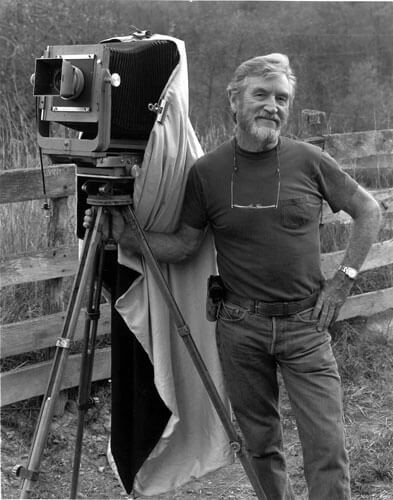Cole Weston, born on January 30, 1919 in Los Angeles, was the fourth and youngest son of famed 20th Century photographer, Edward Henry Weston. Cole received his first camera, a 4 by 5 Autograflex, from his brother Brett in 1935. Cole graduated with a degree in theater arts from the Cornish School in Seattle in 1937 and then served in the Navy during World War II as a welder and photographer. After his discharge from the Navy in 1945 Cole worked for Life Magazine. In 1946 he moved to Carmel to assist his father Edward. During this time Eastman Kodak started sending their new color film, Kodachrome, for Edward to try out. Cole took this opportunity to experiment with this new medium and eventually became one of the world’s great masters of fine art color photography.
In 1957 Cole began shooting his first color photographs of the magnificent Big Sur coast, Monterey Peninsula and central California. At this time he carried on his own portrait business while assisting his ailing father, who passed away in 1958. Edward had authorized Cole to print from Edward’s negatives after his death, so Cole continued printing Edward’s work while pursuing his own fine art photography.
In 1975 Cole began lecturing and conducting workshops on his father’s photography as well as his own. With his work in the theater arts Cole was a natural when it came to teaching and lecturing and his many students still comment on what a great workshop he gave. He traveled throughout the United States, England, Europe, Russia, Mexico, New Zealand and the South Pacific photographing and inspiring others with his characteristic enthusiasm and charm.
In 1988 after three decades devoted to printing his father’s work, Cole at last set aside his responsibility to Edward’s legacy and refocused on his own photography. Cole had his first solo exhibition in San Francisco in 1971. Since then, his work has been featured in more than sixty exhibitions worldwide and has been collected by museums throughout the United States and Europe. His work has been featured in numerous gallery shows and publications with three monographs and numerous articles having been published on his exquisite photography. Michael Hoffman from Aperture Publications once quoted, “In the history of photography there are but a few masters of color photography, Cole Weston is assuredly one of these masters of the medium whose dramatic powerful images are a source of great joy and pleasure”. Cole passed away from natural causes on April 20th, 2003.
Like Cole, who once carried on the legacy of his father’s photography, his children have decided, as a tribute to their father, to carry on printing and offer Trust prints of Cole’s fine color photographs. Cole Weston was a dedicated artist and master of fine photography. Hopefully the availability of modern prints will make it possible for photographic enthusiasts everywhere to continue to enjoy his life’s work.
Selected Books on

